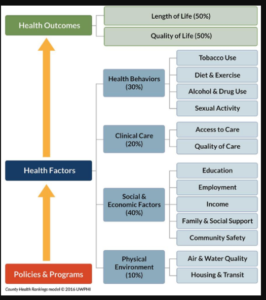Since the pandemic struck, there has been a quest to find new ways to deliver healthcare. Innovation was imminent to find a cure for this deadly virus and change business processes around how the healthcare delivery model worked. The goal was to offer comfortable and convenient access to healthcare, combined with utmost safety, for everyone involved in the continuity of care.
As leaders in healthcare technology, we have been first-hand witnesses to this evolution. In this blog, I will discuss a few key innovations that can help the healthcare industry tide over these challenging times.
a). Leveraging Social Determinants of Health to improve the patient engagement
Based on a county health model ranking the social determinants contribute to 80% of factors that determine patient health outcomes. This is a significant risk factor as more and more health systems move to value-based care models. Therefore, technology tools that help provide valuable insights about the patient’s socioeconomic condition, are bound to drive healthcare innovation.
The Social Determinants of Health (SDOH) can then be combined with the clinical data to generate powerful insights for providers and payers to enable value-based care. For instance, providers can leverage these insights to improve patient’s risk scores, as well as to determine how a care plan needs to be designed for their patients keeping these factors in mind.
Source: County Health Rankings Model 2016
b). Zero-touch workflows
From one-touch workflows to virtual visits, the current pandemic has brought multiple changes to the practice workflows, both internal and external. The zero-touch workflows are here to stay where the patient would be allowed to do a curbside check-in while eating their hot burgers in the car. Providers who care about patient safety would make sure to offer multiple ways to access healthcare. Virtual visits, QR code-enabled check-in processes, are a few examples.
There has also been a significant rise in telehealth visits over the last few years. Since the pandemic began, telehealth usage has ranged from 5.07% to 13% of private insurance claims. Technological improvement will further help improve and make these changes to the workflows permanent, indicating a positive change for the healthcare industry.
c). Remote Patient Monitoring (RPM)
No other innovation can take the place of Remote Patient Monitoring when it comes to providing high-quality care to more patients at affordable cost, and with minimal physician burnout. From wearables to therapeutic apps, healthcare management is now at the hands of the consumers. More and more device sensors, actuators, and device monitoring technology are being integrated into the EHRs and Practice Management workflows, allowing consumers and clinicians to monitor health making the overall healthcare delivery experience, seamless and easy.
d). Big data and Artificial Intelligence
The idea that systems can learn from data, identify patterns, and make decisions with minimal human intervention using deep learning mathematical algorithms is going to have a larger impact on the different business processes within the healthcare systems. When combined with predictive capacities of Artificial intelligence, it will allow providers to improve proactive care, identify patterns to determine the future course of illness, and design appropriate treatment courses.
e). Digital payments
When it comes to healthcare payments, adopting manual payments is proving to be costlier, now more than ever before, no pun intended! According to CAQH Index Report 2020, the annual spend on administrative payments cost is $39 billion. The industry can save $16.3 billion, or 42 percent of existing annual spending, by transitioning to fully electronic transactions. The hassles of mailing paper cheques, wait times for the cheques, and all the other hidden administrative costs associated with manual payments should be reason enough for digital adoption. The consumer payments options are also changing drastically from contactless payments to digital currency.
Over the last year, the velocity of technology change has increased with continuous innovation, most of which are here to stay and become the New Normal of healthcare delivery!
References
- https://www.healthleadersmedia.com/innovation/telehealth-usage-rises-increase-covid-19-cases
- https://www.cdc.gov/mmwr/volumes/69/wr/mm6943a3.htm
- https://www.caqh.org/sites/default/files/explorations/index/2020-caqh-index.pdf
<a href=”https://www.freepik.com/vectors/business”>Business vector created by jcomp – www.freepik.com</a>



